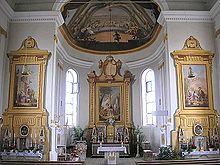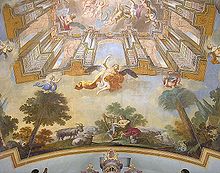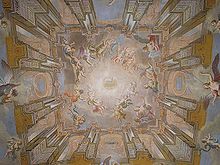St. Martin (Baindlkirch)
The Catholic parish church of St. Martin is an early classicist hall building in the Rieder district of Baindlkirch in the Aichach-Friedberg district in Swabia . It belongs to the diocese of Augsburg . The painting of the church is considered " one of the last significant achievements of Augsburg fresco painting in the tradition of the 18th century " ( Dehio ).
history
The core of the church tower goes back to the 16th century. The nave and the choir were rebuilt in 1808/09. The Augsburg academy director Johann Joseph Anton Huber then began the painting, which was completed in 1810. The choir fresco bears the signature: J. Huber, Acad. Direc. Augusta inv. Et pinxit 1810 .
The church was extensively renovated from 1978.
description
The parish church is located on a hill in the center of the village and is surrounded by the parish cemetery. The exterior is kept very simple. A few slender arched windows illuminate the interior. The west facade is preceded by a low sign (porch), which allows entry into the church.
The tower with its gable roof and curved gables rises in the northern corner of the choir . The two-storey sacristy is located in the southern corner of the choir .
Furnishing
The interior looks very classy and representative due to its high-quality painting. The walls are structured by pilaster-like double wall templates with Ionic capitals . The vaults in the choir and nave have large ceiling frescos. The altars, too, are only painted on the walls, but are cleverly emphasized spatially through painted shading.
The main fresco (nave) shows the heavenly Jerusalem with the adoration of the Lamb. In the middle part, an elaborate column architecture opens the room seemingly towards the sky. Floating putti form a dance around the Lamb of God. In the east and west, romantic landscapes complete the picture, which clearly point to the 19th century, while the central section is still largely in the tradition of the 18th century.
Holy Communion can be seen in the choir . This scene also takes place in an elaborate pseudo-architecture .
Below the painted high altar is flanked by two arched windows. The altarpiece shows St. Martin donating the coat. The framing altar architecture is kept in early classical forms.
The two side altars show the birth of Christ (left) and the Holy Family . The superstructures are based on the design of the high altar.
The pulpit is still in the shape of the 18th century, but thanks to its restrained design it fits seamlessly into the room.
Under the pilasters on the wall there are apostle medallions , which probably also originated from Huber's hand.
To the east of the pulpit is a late Gothic St. Martin on a wall bracket. The saint is shown as a bishop with staff and book. The St. Martin's goose sits at his feet .
To the west, the room is closed off by a simple, two-story gallery on round pillars. The two-part organ prospectus in rococo forms is set up on the upper floor.
literature
- Georg Dehio : Handbook of German Art Monuments, Bavaria III; Swabia (arr.: Bruno Bushart, Georg Paula). Munich and Berlin 1986.
- Georg Paula , Christian Bollacher: Aichach-Friedberg district (= Bavarian State Office for Monument Preservation [Hrsg.]: Monuments in Bavaria . Volume VII.87 ). Karl M. Lipp Verlag, Munich 2012, ISBN 978-3-87490-591-6 , p. 487-489 .
Web links
Individual evidence
Coordinates: 48 ° 16 '36.6 " N , 11 ° 5' 40.3" E




